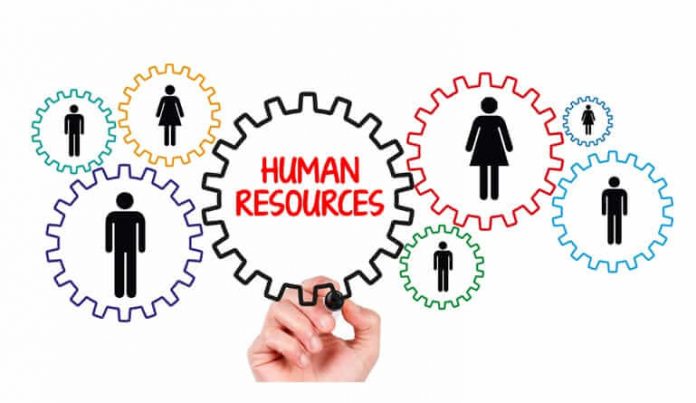This article has been written by Ashna Khanna pursuing a Diploma in Strategic HR for Startups and Emerging Industries from Skill Arbitrage.
This article has been edited and published by Shashwat Kaushik.
Table of Contents
Introduction
In simple words, human resource management refers to managing employees. It involves recruitment, selection, training and development, and retention of employees. The main objective is to maximise the productiveness of an organisation by ensuring that its employees are well-equipped, motivated and aligned with the organisation’s goals and culture.
An organisation’s external environment is made up of vendors, competition, suppliers, the labour force, shareholders, society, technology, the economy, and the government. In order to fight the various types of competition, it is important for an organisation to have a strong human resource management system.
Along with human resource management promoting employee engagement through performance management, compensation, rewards, recognition, etc., they also promote diversity and inclusion, which are equally important for any organisation to grow and develop.
Promoting diversity and inclusion means that people of different individual characteristics, values, beliefs, and backgrounds come under one roof to work together. Therefore, it becomes the duty of the human resource management system to make all employees feel respected, accepted, supported and valued.
What is a supply chain
The supply chain refers to a network of people and companies, such as vendors, producers, warehouses, transportation companies, distribution centres, and retailers, that are involved in the production and delivery of products and services. The four main areas of the supply chain are integration, operation, Purchasing and distribution.
What is a supply chain management
The procedure of managing the flow of goods and services to and from an organisation or business involves every step involved, from turning raw materials into final products to getting them to the customers. The five phases of supply chain management include planning, sourcing, manufacturing, delivery and returns.
- Planning- Organisations must speculate on their future needs and plan accordingly by taking into account the raw materials required during each stage of manufacturing, equipment capacity and limitations, as well as their staffing needs. Large organisations mostly rely on Enterprise Resource Planning (ERP) software for this process.
- Sourcing- SCM sourcing ensures that the raw materials meet manufacturing specifications needed to produce goods, the prices paid to suppliers are in line with market expectations, suppliers have flexibility to deliver raw materials in case of emergency, and the supplier has a proven record of delivering goods of high quality on time.
- Manufacturing- This is the most important phase of the SCM process, where the organisation uses its labour and machinery to transform raw materials into final goods and services.
- Delivery- Once the final products are made and sales are finalised, it is important for the organisation to get them out in the market and into the hands of the customers . Hence, an organisation with effective SCM will have robust logistic capabilities and delivery channels to ensure safe, timely and economical delivery of its products.
- Returns- It is unfortunate when a customer needs to return a product and it’s even more unfavourable if it’s due to an error on the organisation’s part. So, the SCM process concludes with support for the product and customer returns. This process of return is also called reverse logistics, where the organisation must ensure that it has the capabilities to receive returned products and correctly give refunds for them.
Returns can be a highly valuable form of feedback, helping the organisation identify defective products and make the necessary changes required to improve them. However, without addressing the primary cause of customer returns, the supply chain management process will fail and future returns will likely persist.
What is supplier relationship management
Supplier Relationship Management systematically evaluates vendors that supply goods, materials and services to an organisation, determining their contribution to success and developing strategies to improve their performance. Therefore, it is an approach that connects the supply chain and their key suppliers with the goals of an organisation in order to successfully attain untapped business opportunities.
Hence , SRM concentrates on interactions with suppliers, while SCM focuses on the entire supply chain, step by step, from raw materials to finished products.
SRM and its importance
As an organisation requires various goods and services for its daily operations, it is very important for human resource management to build good relations with different suppliers. Building strong and long term relationships with diverse suppliers can be a source of innovation and new ideas, which can help solve existing problems in different ways.
Diverse suppliers can help an organisation solve problems or challenges that they may be facing by creating innovative products as they bring different perspectives and experiences with themselves, which could lead to truly unique solutions.
Hence, supplier relationship management serves as a critical function in many organisations, as good relationships with different vendors can lead to better planning, better pricing, creative and unique solutions, lesser risk in operations, and shorter supply chains. Maintaining good relations with suppliers can be extremely beneficial in the long -run for the organisation.
As human beings evolve and grow, so do businesses and organisations, as well as their HR procurement needs. Strengthening and building relations with various suppliers can provide critical tools and services that can help organisations manage their human resources effectively.
In order to build a strong relationship with suppliers, it is important to:
- Communicate regularly and effectively with the suppliers.
- Show appreciation for their services by sending them mail and small gifts on special occasions.
- Be honest and transparent with all your dealings with them.
- Send their payment on time, as it will help build trust between both of you.
- Involve them in the decision making process as much as possible, as this will show that you value their opinions and expertise.
- Develop and implement policies and procedures that promote diversity and inclusion in the supply chain. This includes policies that prohibit discrimination against suppliers based on race, gender, ethnicity, sexual orientation, or disability.
- Provide training to employees on the importance of diversity and inclusion. This training can help employees understand the benefits of diversity and inclusion and develop the skills needed to work effectively with diverse suppliers.
- Work with suppliers to develop and implement diversity and inclusion initiatives. This can include initiatives such as supplier diversity programmes, mentorship programmes, and training programmes.
- Monitor and evaluate the progress of diversity and inclusion initiatives. This includes tracking the number of diverse suppliers, the amount spent with diverse suppliers, and the satisfaction of diverse suppliers.
By taking these steps, HRM can help create a more inclusive and sustainable supply chain.
Traditional procurement practices vs supplier relationship management
Many years ago, traditional procurement practices only focused on obtaining the best price for goods and services. Since the discovery and practice of supplier relationship management, organisations have placed more importance on building long term relationships with suppliers . SRM strategically selects suppliers based on their abilities to meet the organisation’s needs, monitors and evaluates their performance, and collaborates with them to improve product quality, reduce lead time and increase customer satisfaction. Consequently, SRM has shifted the focus from short-term cost savings to long-term value creation via supplier collaboration and partnerships.
Benefits of supplier relationship management
The benefits of supplier relationship management are:
- Good quality of products & services- As the supplier’s performance is monitored and evaluated, the organisation with the supplier is able to identify areas for improvement and enhance their work. As a result, this leads to better quality products and services, increased reliability and reduced lead times.
- Increased cost savings- Cost is reduced by selecting suitable suppliers and negotiating better terms with the organisation. This leads to an increase in profits.
- Increased customer loyalty- Building strong relationships with suppliers helps organisations collaborate more effectively, which in turn improves product quality, reduces lead times, and increases customer satisfaction and loyalty.
- Mitigate risks- Building strong relationships with suppliers helps the organisation mitigate and reduce risks in the supply chain, such as disruptions, quality issues and compliance concerns.
- Improved supply chain visibility- Organisations become more visible when they start building good relations and collaborating with suppliers, which helps them make informed decisions and respond to changing market conditions in a timely manner.
- Increased efficiency- Organisations become more efficient by streamlining procurement processes and supplier lead times.
- Strategic advantage- Organisations can achieve the competitive advantage of accessing specialised expertise, new technologies and unique products and services once they start developing strong supplier relations and maintaining them.
Challenges faced in implementing the SRM programme
The four common challenges faced by an organisation when implementing the SRM programme are:
- Supplier resistance- The biggest challenge is getting suppliers to buy into the process. In the initial stages, suppliers may abstain from sharing information, collaborating, or changing their processes to align with the organisation’s goals. In order to overcome this challenge, the companies must communicate the benefits of SRM to suppliers so as to build trust and mutual respect.
- Lack of internal support- It is important for companies to ensure that there is a clear understanding of the benefits of the SRM programme so that there are significant resources and support from across the organisation whenever required. This is necessary, as without buy-in from key stakeholders, such as senior management, procurement, and supply chain teams, the implementation may fail.
- Training and development- For the SRM programme to be effective, the employees need to have the necessary skills and knowledge to manage supplier relationships. To ensure that employees have the required expertise, organisations need to invest in WorldCC SRM certification and WorldCC membership to impart employees with the skills and knowledge necessary to implement SRM practices effectively.
- Limited technology infrastructure- For the SRM programme to be effective, there should be a robust technology structure to manage supplier information, track performance and facilitate collaboration.
Future of SRM
The future of supplier relationship management will be very favourable, as organisations will be building strong relationships with suppliers in order to improve the quality of their products and services and will use the right technology and data analytics to improve supplier performance, which will reduce costs and increase profits. Organisations need to be well informed about the new technologies and data analytics so that they can get deeper insights into the suppliers in order to further optimise supplier networks and drive better business outcomes. Organisations that practise sustainability and ethical sourcing are likely to enjoy a competitive advantage in the future as more customers seek out environmentally friendly products.
Conclusion
Therefore, from the above research, it is clear that supplier relationship management would be extremely beneficial for organisations, as it would help them build and maintain strong relationships with their suppliers in order to accomplish their strategic goals effectively. The SRM programme will be of good help to the organisations as they will be able to improve supplier performance, which in turn will aid in the production of better quality products, increase reliability, reduce lead times, reduce costs, reduce risks, increase efficiency, enhance collaboration and increase customer loyalty towards the organisation. Hence, by building strong supplier relations, the organisations would be able to increase their profits as well as achieve great business success.
References
- https://www.shopify.com/blog/what-is-human-resource-management
- https://www.investopedia.com/terms/s/scm.asp
- https://us.sagepub.com/sites/default/files/upm-assets/126593_book_item_126593.pdf
- https://www.linkedin.com/pulse/supplier-relationship-management-world-commerce-contracting/
- https://www.netsuite.com/portal/resource/articles/erp/supplier-relationship-management-srm.shtml
- https://www.supplychaindive.com/news/supplier-diversity-inclusion-business-imperative/603736/
- https://oboloo.com/blog/the-importance-of-building-strong-relationships-with-suppliers-in-hr-procurement/














